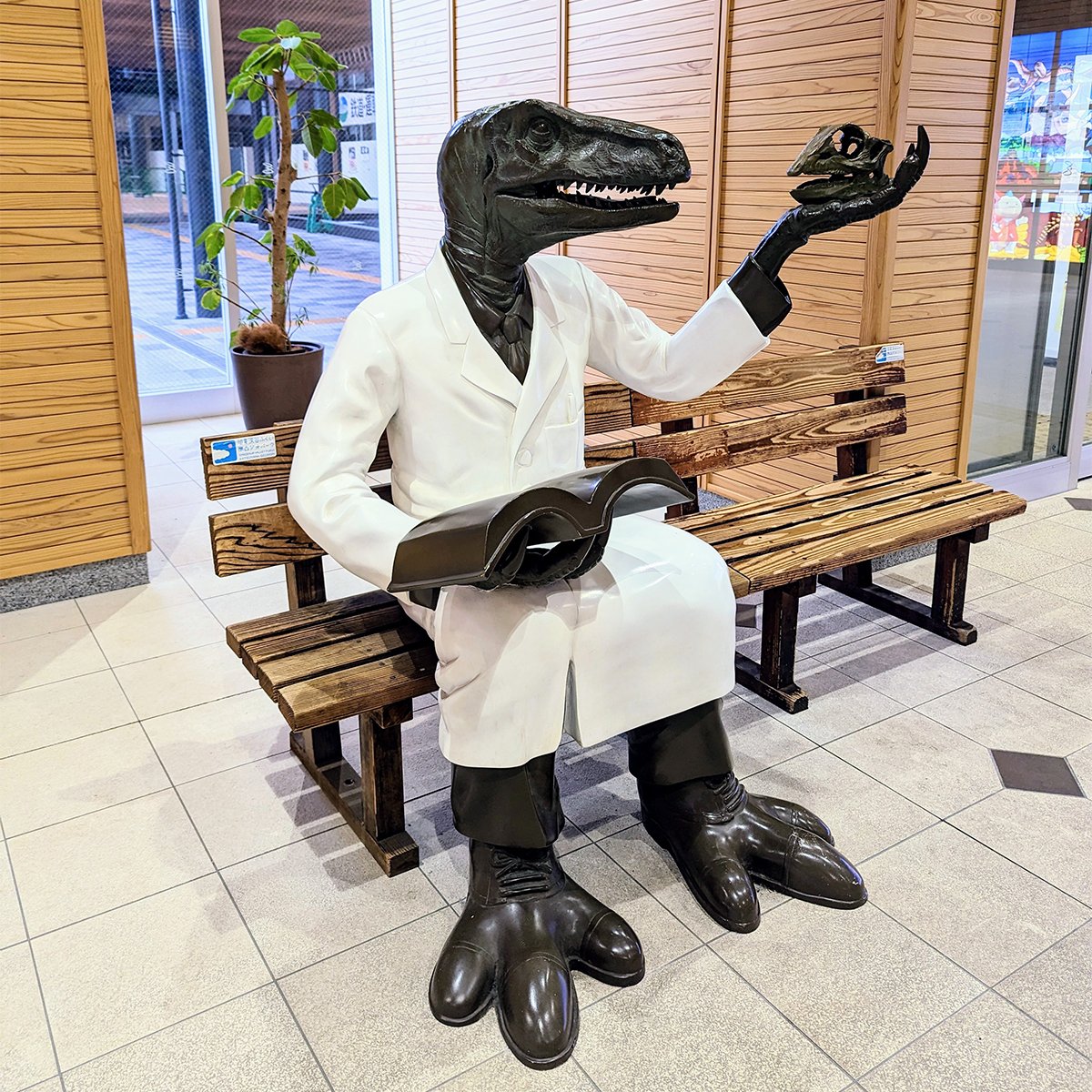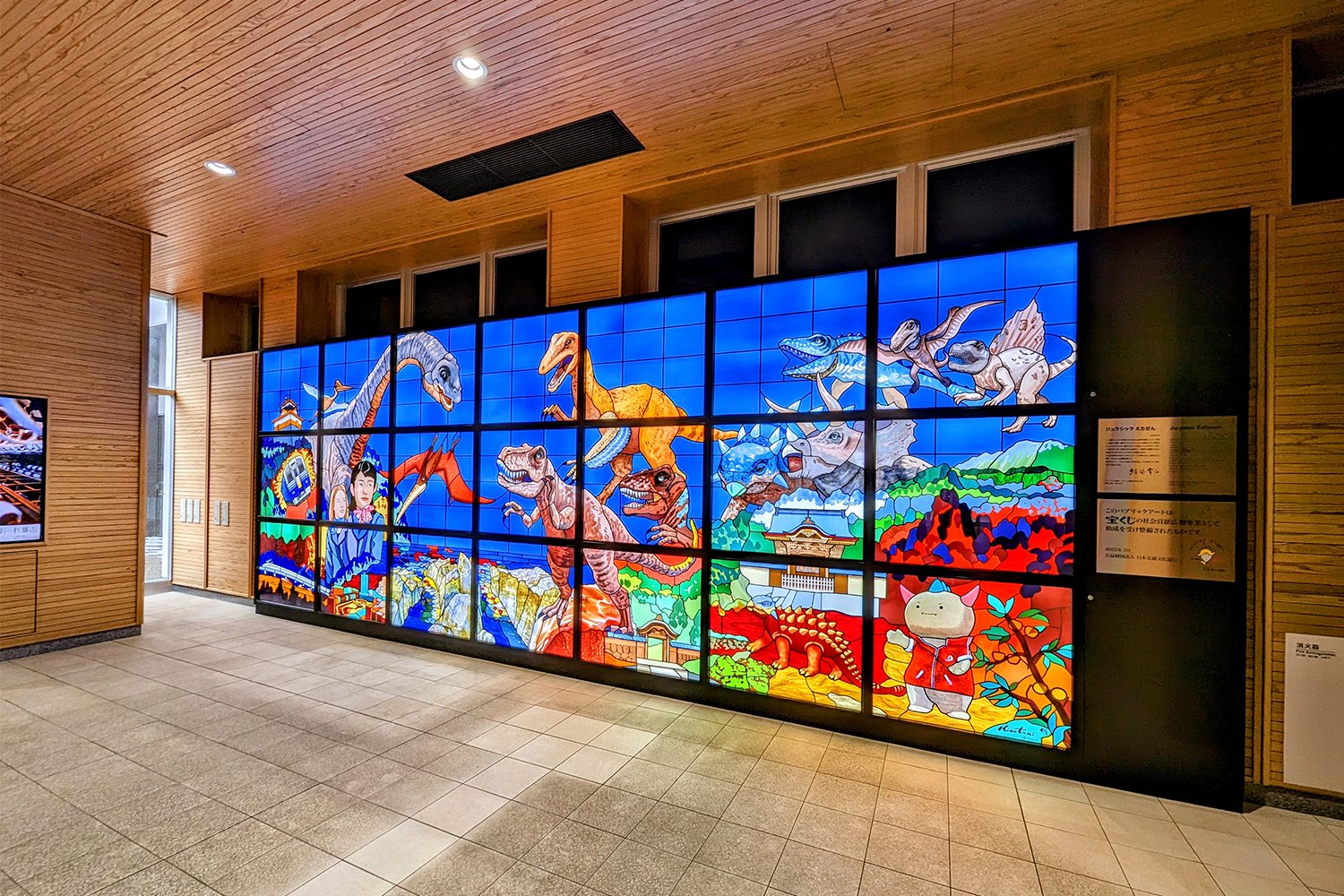Intro to Fukui

The local capital offers access to serene nature, seafood, and dinosaurs.
Cover photo: Admiring an animatronic Fukuititan nipponensis at Dinosaur Square in front of Fukui Station (left) and commercial complex Happiring (right), Fukui City, Fukui Prefecture, Japan (2022).
Please click on an image above for more details.
Map of Japan featuring Fukui Prefecture (福井県). Via Nippon.
Intro
Ranking high in happiness and low in crowds, Fukui (pronounced like “foo-koo-ee”) is arguably Japan’s best-kept secret. The prefecture is home to one of the world’s largest dinosaur museums and most important Zen monasteries. The seaside coastline also offers beaches, dramatic rock formations, and succulent snow crabs.
The name “Fukui” (福井) refers to both the prefecture (Fukui-ken) and capital city (Fukui-shi). It’s said to originate from the “fuku-no-i” (福の井) on castle grounds — literally “well of fortune.”
Home to just 256,000 people, Fukui City is the smallest capital in central Japan’s Hokuriku Region. On clear nights, it’s possible to see stars. Though Fukui is just north of Kyoto, even locals there don’t know much about it!
I have lived in Fukui for over two years now, thanks to the Japan Exchange and Teaching (JET) Program. While I sometimes miss the excitement of larger cities, I’ve come to appreciate the area’s sleepy, suburban vibe. In fact, humble Fukui boasts some truly beautiful places and wonderful experiences.
With the extension of the Hokuriku Shinkansen into Fukui this year, I’m excited for more people to discover this area. Please read on for more highlights, tips and recommendations.
History
Fukui Prefecture is comprised of former provinces Wakasa and Echizen. The latter of which was ruled by the Asakura Clan (朝倉氏) from their seat of power in Ichijodani (Valley) — preserved as the nation’s largest medieval ruins. The Echizen name is still used today for many local places and traditions.
Fukui City dates back to 1575, developing as a castle town under the rule of samurai Katsuie Shibata (柴田 勝家), retainer to famed feudal lord Nobunaga Oda (織田 信長). The surviving moat of Fukui Castle now guards local government buildings!
Coastal towns Mikuni (Sakai), Tsuruga, and Obama grew prosperous in the 17th century thanks to the Kitamae-bune (“cargo ship”) trade route between Osaka and Hokkaido. Tsuruga remains one of the largest ports on the Sea of Japan, connecting the nation to Korea and China.
While Fukui City was devastated in the last century by American air raids in World War II and a major earthquake, it has risen like a phoenix from the ashes. The mythical bird is a city symbol! The surrounding prefecture is a major producer of rice, textiles, glasses, and nuclear power.
Dinosaur Kingdom
Fukui is called the Dinosaur Kingdom as some 80% of the nation’s fossils were discovered here, including six species unique to Japan. Accordingly, the prefecture’s top attraction is state-of-the-art Fukui Prefectural Dinosaur Museum in Katsuyama. Considered among the largest in the world, this colossal institution features original fossils, animatronics, hands-on activities, and a themed cafe. English language accommodation is good too!
The museum can be accessed by public transportation from Fukui Station. There is a direct bus service running on weekends and holidays. Reservations are required for both museum entrance and bus seating!
Spirituality
The prefecture offers many alluring temples, most notably secluded Eiheiji, “Temple of Eternal Peace.” It’s one of the most important Zen monasteries active today, with over 100 practicing monks. Apple co-founder Steve Jobs even considered studying here!
Visitors can tour Eiheji complex for a small fee or apply for an overnight temple stay, featuring guided meditation and carefully-prepared vegetarian meals. In partnership with the temple, nearby hotel Hakujukan also offers authentic Zen experiences. I want to try it!
Sitting upon the base of Mount Hakusan, both Echizen Daibutsu and tranquil moss shrine Heisenji are located in nearby Katsuyama. The Echizen Daibutsu (“Great Buddha”) is one of the largest in Japan! Heisenji is best in rainy season, around June.
Nature & Activities
Blessed with beautiful nature, Fukui residents love the outdoors, no matter the season. Popular activities include camping and hiking, skiing and swimming.
The prefecture’s most famous site is a unique seaside cliff with octagonal columns. This geological phenomenon was formed by volcanic magma millions of years ago. According to local legend, a rebellious monk called Tojinbo (東尋坊) died here, giving the spot its name. Visitors can walk the cliffs freely, admire the coast from Tojinbo Tower, or enjoy a scenic half-hour boat ride.
I also love nearby Mikuni Sunset Beach. Swimming season is around July/August. Located in the southern area of Reinan, Wakasa-wada Beach is among the first in Asia to earn Blue Flag environmental certification.
For thrill-seekers, there’s Tree Picnic Adventure Ikeda offering ziplines, waterpark Shibamasa World (best in summer), and Ski Jam Katsuyama for snow sports (best in January/February).
I highly recommend a visit to Mikata-Goko, or the Five Lakes of Mikata. The sight from Rainbow Line Summit Park is breathtaking. Additionally, Lake Suigetsu is a major scientific landmark, setting a global standard for radiocarbon dating. Consider exploring the area with Mikata Goko Tours.
Fukui also features many stunning flower fields, blooming throughout the year, such as daffodils, azaleas, and lilies. Of course, there are plenty of sakura (cherry blossoms) as well. The Asuwa River in Fukui City features a promenade of over two kilometers (one mile). It’s my favorite sakura spot in Japan!
Cuisine
One of Fukui’s many highlights is delicious food. The nation’s most popular rice strain, Koshikari, was cultivated here! Fukui is especially famous for snow crab called “Echizen gani.” Freshly caught in November, this is a favorite delicacy of Japan’s Imperial Family!
Mackerel, herring, sea bream, squid, and sweetfish are also popular. There are many great restaurants in and around shopping complex Happiring. Try local chain Texas Hands for a uniquely-Japanese take on pizza.
Fukui produces Japan’s best soba (buckwheat noodles) too. The prefecture has won national awards for the past three consecutive years. Low in fat but high in fiber, protein, vitamins, and minerals, buckwheat is often called a superfood.
The local specialty is “Echizen oroshi soba,” cold noodles served with grated daikon (radish). “Sauce katsudon” — fried pork cutlets on rice, glazed with light Worcestershire — is another famous dish.
Events
There’s a great range of events in Fukui, including traditional city festivals, flower viewings, outdoor concerts, and other unique celebrations. Mikuni Fireworks Festival is my favorite, with the grand show taking place right over the sea. I also recommend checking Happiring for events near Fukui Station.
The following is a list of popular events throughout the year.
Eiheiji New Year’s Eve Bell Ringing DECEMBER/JANUARY
Echizen Coast Daffodil Festival (seasonal flowers) JANUARY
Mihama Hiruga Underwater Tug-of-War JANUARY
Ono Detchi Yokan Festival (traditional sweets) FEBRUARY
Echizen Ono Winter Story (winter festival) FEBRUARY
Katsuyama Sagicho (city festival) FEBRUARY
Wakasa Omizu-Okuri (sacred water ritual) MARCH
Fukui Cherry Blossom Festival (seasonal flowers) MARCH/APRIL
Tsuruga Hanakae Festival (romantic flower exchange) APRIL
Nishiyama Park Azalea Festival (seasonal flowers) MAY
Mikuni Festival (historical floats) MAY
Echizen Pottery Festival MAY
Yuri-no-Sato Park Lily Festival (seasonal flowers) JUNE
Green Flash Shibamasa (outdoor concert) JUNE
Awara Kanazu Festival (city festival) JULY
Wakasa Ohi Super Ogase (fire festival) AUGUST
Fukui Phoenix Festival (city festival) AUGUST
Echizen Ono Castle Festival (city festival) AUGUST
Mikuni Fireworks Festival (beachside fireworks show) AUGUST
Asakura Warring States Festival (historic reenactment) AUGUST
Eiheiji Floating Lantern Festival (memorial) AUGUST
Awara Yukake Festival (water-throwing festival) AUGUST
Tsuruga Festival (city festival) SEPTEMBER
Fukui One Park Festival (outdoor concert) SEPTEMBER
Echizen Fish Festival SEPTEMBER
Obama Hoze Festival (city festival) SEPTEMBER
Renew Fukui (traditional crafts festival) OCTOBER
Takefu Chrysanthemum Doll Festival OCTOBER/NOVEMBER
Fukui Coffee Festival NOVEMBER
Echizen Crab Festival NOVEMBER
Tsuruga Port Illumination NOVEMBER/DECEMBER
Transportation & Accommodation
Fukui is about a three-hour trip from Tokyo and two hours from Osaka. Fukui City is the perfect base to enjoy the prefecture. Most hotels are located around Fukui Station, with close proximity to restaurants and bars.
Courtyard by Marriott Fukui is scheduled to open this March, featuring multiple restaurants, and Japanese-style hotel Onyado Nono Fukui is expected to open in October, 2025.
Fukui’s top attractions are spread across the prefecture. It’s not especially easy to reach all of them by public transportation. I recommend renting a car. Taxis are also an option, though they are notoriously expensive. There’s also a new sightseeing program, called Happy Bus, but tours are only offered on weekends and holidays, and conducted in Japanese.
Top Attractions
Fukui Prefectural Dinosaur Museum RESERVATION REQUIRED
Eiheiji (13th century Buddhist monastery)
Tojinbo (seaside cliffs)
Ichijodani Asakura Clan Ruins (medieval site with museum)
Echizen Daibutsu (Buddhist temple)
Mikata Fives Lakes & Rainbow Line (scenic area)
Heisenji (moss shrine)
Maruoka-jo (one of Japan’s twelve original castles)
Yokokan Garden (Edo Period villa)
Additional Ideas
There’s also a variety of local crafts available to make, buy, and learn about. Echizen Town is recognized as one of Japan’s six ancient pottery kilns. It’s also famous for washi (Japanese paper). Takefu specializes in Japanese steel knives and Sabae produces virtually all of the nation’s glasses.
Author’s Note
As part of the Fukui Reporter program, I am tasked with participating in local events and publicly promoting the prefecture. This is a volunteer position that allows me free entrance to a selection of museums throughout the area. The opinions I share are my own.






























